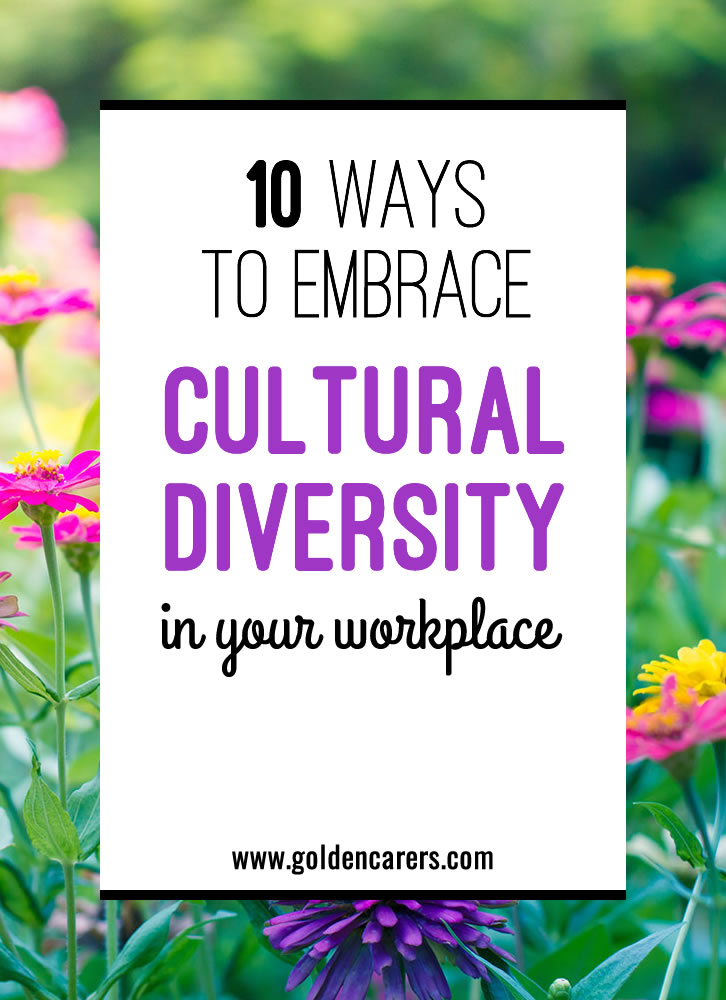
10 Ways to Embrace Cultural Diversity in Your Workplace
Found In: ›Activities ›Articles ›Multicultural ›Coronavirus: Covid-19

In today's world, with an ever-expanding demographic of residents entering long term care homes, it is critical to develop strategies that promote diversity and inclusion.
Embracing cultural diversity means appreciating the differences in individuals from a variety of cultural and ethnic groups within an organization. Inclusion refers to the right of those groups to participate and have equity in all aspects of life.
In this article we cover:
- What is Cultural Competence?
- Why Cultural Competence is Important
- How to Create a Culture of Inclusion
- 10 Tips for Embracing Cultural Diversity in Your Workplace
Related Activities
Comments Post a Comment
 11th Jun 2020
Therapeutic Activities Director
11th Jun 2020
Therapeutic Activities Director
In activities on a smaller scale, I have had a cultural appreciation group, which is a multi sensory travel group where we explore a country like Haiti for example, where many of our staff are from...I print out pictures, play Youtube travel clips to that location, play music, bring food if I can...and I try to do it on an hour when I have nursing assistants helping who are from the same country. It was really special...and its nice to have the other staff involved in activities and enjoying it.

 12th Jun 2020
Activity Director
12th Jun 2020
Activity Director
I worked as an activity director for many years in a facility north of Boston
We had a lunch similar to what you described during
Nursing home week
The other ideas you have a very good and it’s always good if you can get the CNA’s involved in the activities
Thank you for sharing
It sounds like you are doing a great job
 12th Jun 2020
Diversional Therapist
12th Jun 2020
Diversional Therapist
 27th Feb 2019
27th Feb 2019
 2nd Mar 2019
2nd Mar 2019


 23rd Feb 2019
Activity Director
23rd Feb 2019
Activity Director
Another challenge is when some residents especially those with dementia show some prejudice which can be hurtful to the staff
It is a good idea to talk about kindness with your residents even though world kindness day is in November
Here are some ideas
https://www.goldencarers.com/world-kindness-day-ideas/3850/
Despite everyone's best effort's some residents can display hurtfulness

 19th Feb 2019
Retired
19th Feb 2019
Retired
 24th Feb 2019
24th Feb 2019

 How to Get Reluctant Residents to Attend Activities
How to Get Reluctant Residents to Attend Activities
 18 Ways to Bring Live Theater to Your Community
18 Ways to Bring Live Theater to Your Community
 15 Virtual Activities for Residents in Isolation
15 Virtual Activities for Residents in Isolation
 How to Setup a Pet Visiting Program
How to Setup a Pet Visiting Program


According to Google
You can put a variety of different things in your culture box, anything that shows who you are. For example: Pictures of friends, family, traditions, celebrations, etc. Things that are important to you like a CD album case, your favorite movie, or necklace your Grandmother gave you.
So it sounds to me like you can do whatever interests the Clients
Here are some coloring activities on golden carers
https://www.goldencarers.com/the-benefits-of-coloring-in-for-the-elderly/4244/